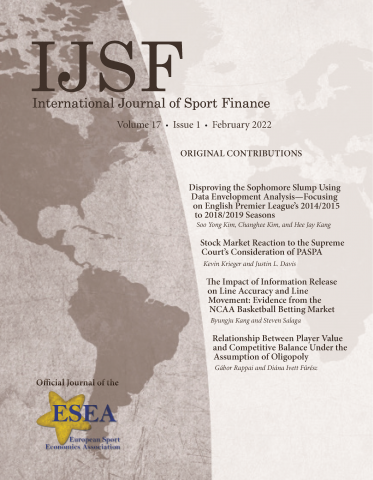International Journal of Sport Finance
Issue 17:1 – February, 2022
Issue 17:1 – February, 2022

Soo Yong Kim, Changhee Kim, Hee Jay Kang
The “sophomore slump” is a widely accepted phenomenon in modern sport culture, commonly conceptualized as a decline in performance during a player’s second year of competition following an outstanding first season. This study empirically verified the absence of sophomore slump through a two-stage network data envelopment analysis and Malmquist productivity index analysis of 616 English Premier League players from the 2014–2015 to 2018–2019 seasons. The relative rankings of individual second-year players were compared with their rankings in the previous season, and second-year and non-second-year player groups were also compared. No evidence was found to indicate the existence of a sophomore slump. In addition, Tobit regression analysis was conducted to analyze the effects of environmental variables such as yellow cards, red cards, and fouls. This study is meaningful because it analyzes “efficiency,” which has a strategic and financial impact not only on individual players but also on team managers and scouts.
Kevin Krieger and Justin L. Davis
A landmark decision (Murphy v. NCAA) by the Supreme Court of the United States (SCOTUS) in 2018 ruled that the federal government could not prohibit individual states from allowing sports wagering. Our study explicitly assesses the stock market’s response to this case’s progression through legal review phases, culminating with a landmark SCOTUS decision. Surprisingly, we find that the stock market failed to efficiently interpret key events precipitating SCOTUS’ eventual decision. Even though serious indications suggested that the Professional and Amateur Sports Protection Act (PASPA) was likely to be overruled, markets did not acknowledge such a possibility early. Instead, prices only responded when SCOTUS’ ruling was finalized.
Byungju Kang, Steven Salaga
Research examining how information influences pricing, efficiency, and line accuracy in sports betting markets is common. The existing literature, however, does not consider that the natural release of information through standard game play may be systematically related to changes in line accuracy. We test this hypothesis and find a statistically significant improvement in line accuracy in both the sides and totals markets as more information is released. This indicates the information produced through game play is valuable in improving contest forecasts by both oddsmakers and the market. We also find a reduction in line movement in both the sides and totals markets as more information is released, suggesting forecasts of oddsmakers and the market converge along with an increase in available information.
Gábor Rappai, Diána Ivett Fűrész
The evolution of competitive balance and its impact on demand is the focus in the field of sports economics. The results of previous studies examining the relationship between competitive balance (CB) and attendance, as well as the direction of the relationship between financial inequality and CB, are not clear. Through panel data of the top five European football leagues, we examine whether there is a causal relationship between the concentration of club wealth and CB. Using different CB measures and the player value concentration as a proxy for wealth concentration, we found that wealth concentration has an impact on competitive imbalance. A partial adjustment model was able to detect the causal relationship even though CB refers to a moment while the wealth concentration refers to a period. This study helps to understand why previous research has found conflicting results on the relationship between financial inequality and competitive balance.